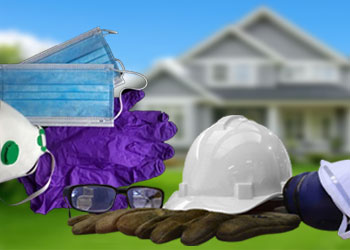 “Personal Protective Equipment” (PPE) typically refers to gear and clothing designed to protect individuals from various hazards in the workplace or other settings. However, the use of PPE at home can also be relevant in certain situations, especially when dealing with potential hazards. Here are a few scenarios where PPE might be appropriate at home:
“Personal Protective Equipment” (PPE) typically refers to gear and clothing designed to protect individuals from various hazards in the workplace or other settings. However, the use of PPE at home can also be relevant in certain situations, especially when dealing with potential hazards. Here are a few scenarios where PPE might be appropriate at home:
- Home Renovation or DIY Projects: If you’re engaged in home renovation or do-it-yourself projects involving power tools, chemicals, or heavy materials, wearing appropriate PPE like safety glasses, gloves, ear protection, and even dust masks can help prevent injuries.
- Gardening and Yard Work: When working in the garden or doing yard work, it’s a good idea to wear gloves, sturdy footwear, and eye protection to prevent cuts, splinters, and debris from getting into your eyes.
- Cleaning with Harsh Chemicals: When using strong cleaning chemicals, wearing gloves and eye protection can prevent skin irritation and accidental splashes in your eyes.
- Cooking and Kitchen Safety: While not traditional PPE, using oven mitts, aprons, and potholders can protect you from burns while cooking.
- Handling Hazardous Substances: If you’re dealing with hazardous materials at home, like paint, pesticides, or certain chemicals, wearing appropriate PPE such as gloves and masks can help minimize exposure.
- Caring for the Sick, or During Pandemics: If you are caring for some who is contagious, is immunocompromised, elderly or during pandemic situations wearing gloves, a mask, and using disposable gowns could help reduce the risk of infection transmission.
- Allergies or Sensitivities: If you have allergies or sensitivities to certain substances like pollen, dust, or pet dander, wearing a mask while cleaning or performing tasks that might stir up these allergens could be helpful.
Remember, the appropriateness of PPE at home depends on the specific activities you’re engaged in, and the potential hazards involved. Always read and follow safety guidelines and recommendations provided with any equipment or materials you’re using. If you’re unsure about the need for PPE at home, consider researching or consulting experts in the relevant field to ensure your safety.
